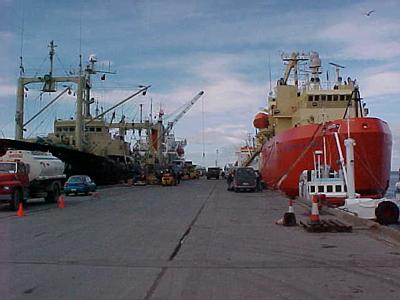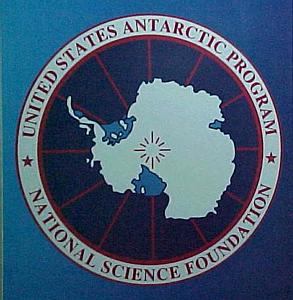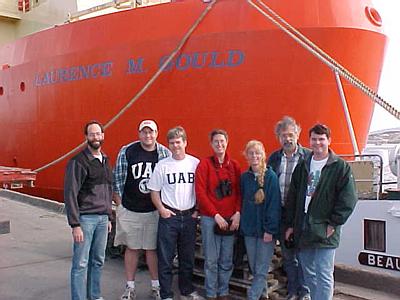1 March, 2000
To Punta Arenas; Board the R.V. Gould
Question 11: What makes a ship an icebreaker?
We got an early start from Puerto Natales to be back in Punta Arenas in time
to board the Gould by 1pm. The 240 km drive took under 4 hours. It was
lovely to be driving on pavement again!
In Punta Arenas, we stopped at the grocery store before we went to the dock
to get whatever fresh fruits or packaged goods we wanted for Palmer and on the
ship. There is no ship store and a very limited one at Palmer Station. If
you forget your soap, you have to be willing to use the brand they have
available. If it is something less common that you have forgotten, you have
to borrow or do without.
We drove out onto the dock and pulled our van right up next to the Gould.
Dr. Chuck Amsler, the only missing member of our party, met us there. We
carried everything that we had in the van onto the ship ourselves. The rest
of our luggage that had been sitting in the AGUNSA warehouse while we drove to
the park had already been lifted on board in a cargo net. We took a few
minutes to clean out the dust from the inside of the van before we returned
it, then got on board.
Room on the ship is limited, especially personal space. Each stateroom has
two bunks with drawers below and a small closet of shelves for each occupant.
I had to reshuffle my gear again so that what I needed was in my cabin and
everything else was stored below decks. Tonight's dinner is the last meal in
a restaurant; it is ship and station food after that.
The dock area is very busy. There is a large fish processing ship opposite
us, some miscellaneous cargo ships further down the dock, and dozens of small
crab, seaweed, and fishing boats moored between us and the shore. Off shore
are some larger crabbing vessels as well as an oil tanker on a mooring near
the oil platform.
Answer 10: While there are penguin species that breed along the coasts of
southern Australia, New Zealand, South Africa, and Chile, the furthest north
is in the Galapagos Islands. The Galapagos penguin lives near the equator, but
it survives there only because of the cold water of the Humboldt Current which
flows from the Southern Ocean. The species is at the limit of its tolerance
there, and in El Nino years when the warm water pushes the Humboldt Current
aside, it fails to reproduce successfully.

The dock in Punta Arenas, Chile with the R.V. Lawrence M. Gould on the right and a fish processor on the left.

NSF's United States Antarctic Program logo; from now on, everything we do is under their jurisdiction.

The bunks in stateroom 204.

My oceanographer roommate Hillary and the closet and desk space in stateroom 204 (had to stand in the head to take the picture, the room is not large).

Our science group(#SO-022) together in front of our ride to Antarctica! L to R: Dr. Chuck Amsler, Andy Mahon, Dr. Jim McClintock, Joanna Hubbard, Dr. Katrin Iken, Dr. Bill Baker, and Bruce Furrow.

Contact the TEA in the field at
.
If you cannot connect through your browser, copy the
TEA's e-mail address in the "To:" line of
your favorite e-mail package.
|
